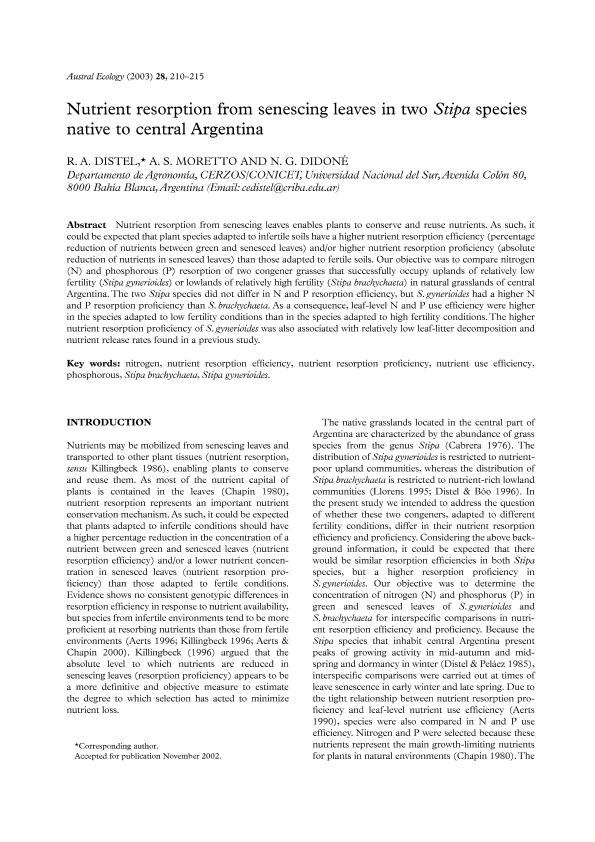Artículo
Nutrient resorption from senescing leaves in two Stipa species native to central Argentina
Fecha de publicación:
04/2003
Editorial:
Wiley
Revista:
Austral Ecology
ISSN:
1442-9985
Idioma:
Inglés
Tipo de recurso:
Artículo publicado
Clasificación temática:
Resumen
Nutrient resorption from senescing leaves enables plants to conserve and reuse nutrients. As such, it could be expected that plant species adapted to infertile soils have a higher nutrient resorption efficiency (percentage reduction of nutrients between green and senesced leaves) and/or higher nutrient resorption proficiency (absolute reduction of nutrients in senesced leaves) than those adapted to fertile soils. Our objective was to compare nitrogen (N) and phosphorous (P) resorption of two congener grasses that successfully occupy uplands of relatively low fertility (Stipa gynerioides) or lowlands of relatively high fertility (Stipa brachychaeta) in natural grasslands of central Argentina. The two Stipa species did not differ in N and P resorption efficiency, but S. gynerioides had a higher N and P resorption proficiency than S. brachychaeta. As a consequence, leaf-level N and P use efficiency were higher in the species adapted to low fertility conditions than in the species adapted to high fertility conditions. The higher nutrient resorption proficiency of S. gynerioides was also associated with relatively low leaf-litter decomposition and nutrient release rates found in a previous study.
Archivos asociados
Licencia
Identificadores
Colecciones
Articulos(CADIC)
Articulos de CENTRO AUSTRAL DE INVESTIGACIONES CIENTIFICAS
Articulos de CENTRO AUSTRAL DE INVESTIGACIONES CIENTIFICAS
Articulos(CERZOS)
Articulos de CENTRO REC.NAT.RENOVABLES DE ZONA SEMIARIDA(I)
Articulos de CENTRO REC.NAT.RENOVABLES DE ZONA SEMIARIDA(I)
Citación
Distel, Roberto Alejandro; Moretto, Alicia Susana; Didone, Nilda Graciela; Nutrient resorption from senescing leaves in two Stipa species native to central Argentina; Wiley; Austral Ecology; 28; 2; 4-2003; 210-215
Compartir
Altmétricas




